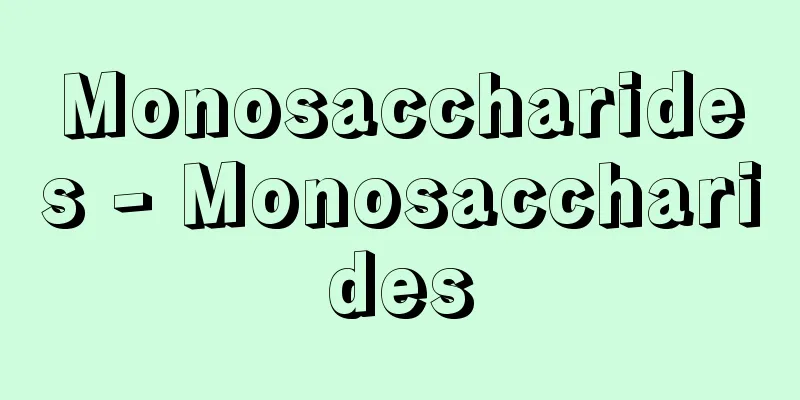Monosaccharides - Monosaccharides

|
A general term for sugars that cannot be hydrolyzed further, also called monosaccharides. Many monosaccharides are physiologically important, including glucose, fructose, mannose, galactose, and ribose. They are generally colorless crystals with a sweet taste, soluble in water, poorly soluble in ethanol (ethyl alcohol), and insoluble in ether. They are widely present in the living world in free form or as components of oligosaccharides, polysaccharides, glycosides, etc., but are rarely found in free form. They are extracted from natural products or obtained by hydrolyzing oligosaccharides and polysaccharides, but can also be chemically synthesized. They have at least two hydroxyl groups and a carbonyl group =O adjacent to them. Most of them can be expressed by the general formula Cn ( H2O ) m , and are called trioses (three-carbon sugars), pentoses (five-carbon sugars), hexoses (six-carbon sugars), etc., depending on the number of C (carbons). Depending on whether the carbonyl carbon is in the aldehyde group -COH or the ketone group =O, they are called aldoses or ketoses. They have an asymmetric carbon atom and many stereoisomers, so they exhibit optical rotation and are divided into two series, D and L. For the simplest aldose, glyceraldehyde, the dextrorotatory (+) type is called the D type, and the sugars derived from it are called the D series, and its counterpart is called the L series. The carbonyl group is usually not free, and forms a pentagonal or hexagonal ring structure, which are called furanose and pyranose, respectively. When the ring is formed, the hydroxyl group generated on the carbonyl carbon gives rise to α (alpha) and β (beta) isomers. In the D series, the one with greater dextrorotatory power is called the α type, and the others are called the β type, while in the L series, the one with greater levorotatory power is called the α type, and the others are called the β type. In the crystalline state, they take either the α or β type, but in solution, an equilibrium is established between the two, and the optical rotation changes over time, eventually reaching a constant value. This phenomenon is called mutarotation. However, when the hydroxyl group generated at the carbonyl carbon is linked to other monosaccharides, alcohols, phenolic substances, phosphates, etc. through glycosidic bonds, it takes either α or β form. Glycosidases are strictly divided into α-type and β-type. Monosaccharides have carbonyl groups, so they reduce ammoniacal silver solution or Fehling's solution, or react with phenylhydrazine to produce osazones. They also have alcohol groups, so they form acids and esters. In terms of changes in solution, dehydration occurs in acidic solutions with high acid concentrations, and epimerization (inversion) occurs in alkaline solutions. When monosaccharides are reduced, they become sugar alcohols. Aldoses and ketoses react differently to oxidation. Aldoses become aldonic acids through mild oxidation, and then lactones, but strong oxidation produces dicarboxylic acids. Ketoses are stable to weak oxidizing agents, but strong oxidizing agents can cleave the carbon chain to produce dicarboxylic acids. [Michiko Iijima] [References] | | | | | | | |Source: Shogakukan Encyclopedia Nipponica About Encyclopedia Nipponica Information | Legend |
|
糖類のうちそれ以上加水分解できない糖の総称で、単糖類ともいう。多くの単糖は生理的に重要であり、おもなものに、グルコース、フルクトース、マンノース、ガラクトース、リボースなどがある。一般に甘味をもつ無色結晶で、水に溶けるが、エタノール(エチルアルコール)には溶けにくく、エーテルには溶けない。遊離形または少糖類、多糖類、配糖体などの構成糖として生物界に広く存在するが、遊離形での存在は少ない。天然物から抽出するか、少糖類、多糖類などを加水分解して得るが、化学的に合成することもできる。最低2個のヒドロキシ基とこれに隣接するカルボニル基=Oをもつ。その多くはCn(H2O)mという一般式で表すことができ、C(炭素)の数によってトリオース(三炭糖)、ペントース(五炭糖)、ヘキソース(六炭糖)などとよばれる。またカルボニル炭素がアルデヒド基-COHにあるかケトン基=Oにあるかによって、アルドースまたはケトースとよぶ。不整炭素原子をもち、多くの立体異性体があるので旋光性を示し、D、L二系列に分けられる。もっとも簡単なアルドースであるグリセリンアルデヒドについて、右旋性(+)のものをD型とし、これより誘導される糖をD系列とし、その対称体をL系列とする。カルボニル基は通常遊離しておらず、五角または六角の環状構造をつくっており、それぞれフラノース、ピラノースとよばれる。環形成の際にカルボニル炭素に生ずるヒドロキシ基に関してα(アルファ)、β(ベータ)の異性体が生ずる。D系列ではより大きな右旋性をもつものをα型、他をβ型とし、L系列ではより大きな左旋性をもつものをα型、他をβ型とする。結晶の状態ではα、βのいずれかの型をとるが、溶液中では両者の間に平衡が成立し、時間とともに旋光度が変化し最後に一定値に達する。この現象を変旋光という。しかし、カルボニル炭素に生ずるヒドロキシ基がグリコシド結合によって他の単糖、アルコール、フェノール性物質、リン酸などと結合している場合は、α、βのいずれかの形をとる。グリコシダーゼにはα型に作用するものとβ型に作用するものとがあり、厳密に区別される。単糖類はカルボニル基をもつので、アンモニア性銀液やフェーリング液を還元したり、フェニルヒドラジンなどと反応してオサゾンを生成する。また、アルコール基をもつため酸とエステルをつくる。溶液中の変化については、酸濃度の高い酸性溶液中では脱水がおこり、アルカリ性溶液中ではエピマー化(反転)がおこる。単糖類を還元すると糖アルコールに変わる。酸化に対してアルドースとケトースでは異なった反応を示す。アルドースは温和な酸化によってアルドン酸となり、さらにラクトンに変わるが、強い酸化ではジカルボン酸が生ずる。ケトースは弱い酸化剤に対して安定であるが、強い酸化剤では炭素鎖の切断を伴ってジカルボン酸が生ずる。 [飯島道子] [参照項目] | | | | | | | |出典 小学館 日本大百科全書(ニッポニカ)日本大百科全書(ニッポニカ)について 情報 | 凡例 |
<<: Warm winter damage - Dantougai
Recommend
Thermonasty
…a property of plant organs bending in response t...
Ammonia soda process - Ammonia soda process
Also known as the Solvay process. A method for pr...
Complexan (English spelling)
A general term for aminopolycarboxylic acids. Also...
The Weaver's Incident
In 1601 (29th year of the Wanli era), a popular an...
Greensboro - Greensboro (English spelling)
An industrial city in the northern part of North C...
Leda - Leda (English spelling)
A woman who appears in Greek mythology. Daughter ...
Anti-business tax movement - anti-business tax movement
A movement of merchants and industrialists that c...
Hyperlipidemia
…Fats usually refer to cholesterol and triglyceri...
Kinpu Shrine
Located on Mt. Kinpu, Yoshino-cho, Yoshino-gun, Na...
receiver
… limiter is a circuit that suppresses amplitude ...
Hahah
… The pioneers of the landscape garden style were...
Emergency takeoff - emergency takeoff
⇒Scramble Source: About Shogakukan Digital Daijise...
Bibliography
Reference books. Source: Yoko Sakae Study Abroad I...
Live Sea Bream Mansion - Ikidaiyashiki
〘Noun〙 (From the fact that a large fish tank was s...
Xilinhot - Shirinhoto
A city in the Xilingol League on the grasslands of...









